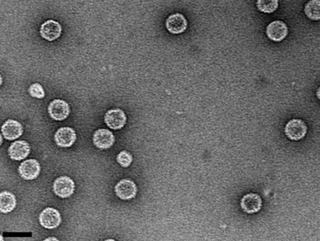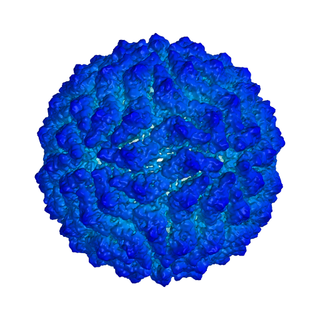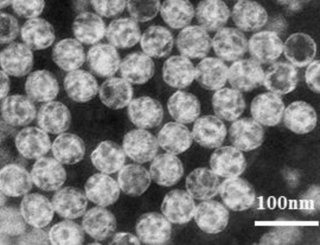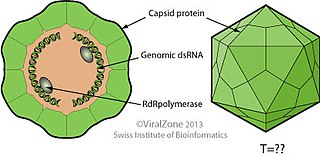
Birnaviridae is a family of double-stranded RNA viruses. Salmonid fish, birds and insects serve as natural hosts. There are currently 11 species in this family, divided among seven genera. Diseases associated with this family include infectious pancreatic necrosis in salmonid fish, which causes significant losses to the aquaculture industry, with chronic infection in adult salmonid fish and acute viral disease in young salmonid fish.

Alphachrysovirus is a genus of double-stranded RNA viruses. It is one of two genera in the family Chrysoviridae. They infect fungi, in particular Penicillium. Their name is derived from the Greek word chrysos which means yellow-green. There are 20 species in this genus.

Picobirnavirus is a genus of double-stranded RNA viruses. It is the only genus in the family Picobirnaviridae. Although amniotes, especially mammals, were thought to serve as hosts, it has been recently suggested that these viruses might infect bacteria and possibly some other invertebrates. There are three species in this genus. Associated symptoms include gastroenteritis in animals and humans, though the disease association is unclear.

Alphaflexiviridae is a family of viruses in the order Tymovirales. Plants and fungi serve as natural hosts. There are 65 species in this family, assigned to six genera. Diseases associated with this family include: mosaic and ringspot symptoms.
Aquabirnavirus is a genus of viruses, in the family Birnaviridae. Salmonid fish serve as natural hosts. There are three species in this genus. A disease associated with this genus, Infectious pancreatic necrosis (IPN) in salmonid fish, causes significant losses to the aquaculture industry. Chronic infection in adults, and acute viral disease in young salmonid fish can occur.

Aquareovirus is a genus of double-stranded RNA viruses in the family Reoviridae and subfamily Spinareovirinae. Fish, shellfish, and crustacean species serve as natural hosts. Aquareoviruses in general have low or no pathogenicity for fish. However, some cause hemorrhagic disease, hepatitis and pancreatitis. Grass carp hemorrhage virus is the most pathogenic aquareovirus. There are seven species in this genus.

Bromovirus is a genus of viruses, in the family Bromoviridae. Plants serve as natural hosts. There are six species in this genus.
Entomobirnavirus is a genus of viruses in the family Birnaviridae. Its natural host is the fly Drosophila melanogaster. There are two species in this genus.

Giardiavirus is a genus of viruses, in the family Totiviridae. Protozoa serve as natural hosts. There is only one species in this genus: Giardia lamblia virus.
Idnoreovirus is a genus of double-stranded RNA viruses in the family Reoviridae and subfamily Spinareovirinae. Hymenoptera insects serve as natural hosts. The genus name is an acronym for insect derived non occluded reovirus. There are five species in this genus.

Mycoreovirus is a genus of double-stranded RNA viruses in the family Reoviridae and subfamily Spinareovirinae. Fungi serve as natural hosts. Diseases associated with this genus include: hypovirulence of the fungal host. The name of the group derives from Ancient Greek myco which means fungus. There are three species in this genus.

Victorivirus is a genus of viruses, in the family Totiviridae. Filamentous fungi serve as natural hosts. There are 14 species in this genus.

Carmotetraviridae is a family of positive-strand RNA viruses. There is only one genus in this family, Alphacarmotetravirus, which has one species: Providence virus. Lepidopteran insects serve as natural hosts.

Megabirnaviridae is a family of double-stranded RNA viruses with one genus Megabirnavirus which infects fungi. The group name derives from member's bipartite dsRNA genome and mega that is greater genome size than families Birnaviridae and Picobirnaviridae. There is only one species in this family: Rosellinia necatrix megabirnavirus 1. Diseases associated with this family include: reduced host virulence.

Quadriviridae is a family of double-stranded RNA viruses with a single genus Quadrivirus. The fungi Rosellinia necatrix serves as a natural host. The name of the group derives from the quadripartite genome of its members where in Latin quad means four. There is only one species in this family: Rosellinia necatrix quadrivirus 1.
Aquaparamyxovirus is a genus of viruses in the family Paramyxoviridae, order Mononegavirales. The genus includes two species. Fish serve as the natural hosts for AsaPV, in which the virus may cause proliferative gill inflammation.
Cardoreovirus is a genus of double-stranded RNA viruses in the family Reoviridae and subfamily Sedoreovirinae. Crabs serve as natural hosts. There is only one species in this genus: Eriocheir sinensis reovirus. Diseases associated with this genus include: trembling disease. The name derives from Latin words "carcinus" which means crab and "doeca" which means twelve in reference to the number genome segments.
Citrivirus is a genus of viruses in the order Tymovirales, in the family Betaflexiviridae. Plants serve as natural hosts. There is only one species in this genus: Citrus leaf blotch virus.

Dinovernavirus is a genus of double-stranded RNA viruses in the family Reoviridae and subfamily Spinareovirinae. Member viruses replicate in a variety of mosquito cell lines. The name is an abbreviation for double-stranded, insect, novem, rna virus. There is one species in the genus: Aedes pseudoscutellaris reovirus.

Trichomonasvirus is a genus of viruses, in the family Totiviridae. The protozoan parasite Trichomonas vaginalis serves as the natural host. There are four species in this genus.













